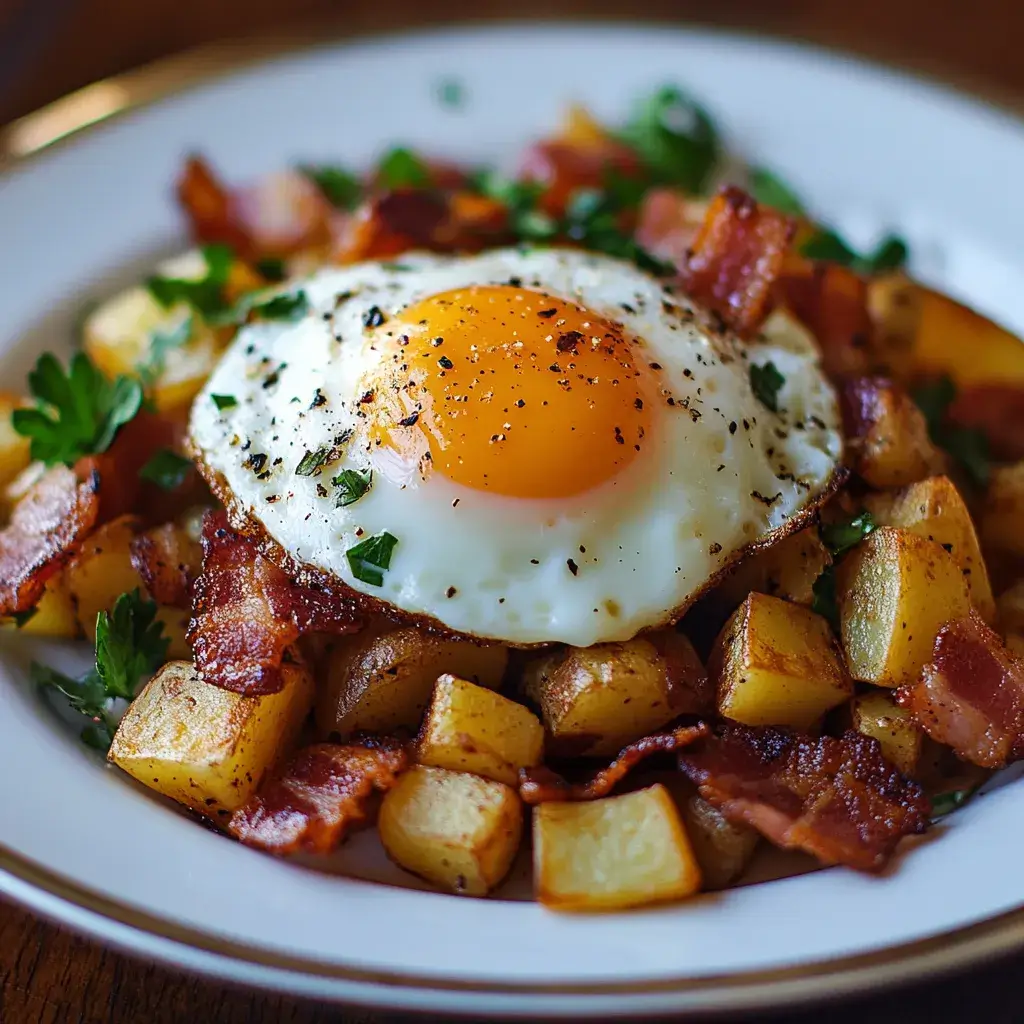Bacon, Egg, and Potato Hash is more than just a breakfast dish—it’s a comforting meal that brings warmth to your mornings. This classic combination of crispy bacon, fluffy eggs, and golden potatoes has been a staple in kitchens worldwide for generations. Whether you’re preparing it for a lazy weekend brunch or a quick weekday breakfast, this hash never fails to deliver satisfaction.
A Classic Breakfast Dish
Hash has its roots in traditional cooking methods where leftover ingredients were combined to create hearty meals. Over time, the dish evolved into a beloved breakfast option, especially in American cuisine. The beauty of hash lies in its simplicity—just a few key ingredients come together to form a dish that’s both filling and flavorful. Its versatility makes it an ideal choice for any occasion, from family gatherings to solo breakfasts.
Key Ingredients in the Recipe
The trio of potatoes , bacon , and eggs forms the foundation of this dish. Potatoes provide a satisfying base, absorbing flavors while adding texture. Crispy bacon contributes smoky depth, elevating the dish with its irresistible crunch. Eggs, whether scrambled or fried, bring creaminess and protein, making the hash a complete meal.
Why You Should Try This Recipe
If you’re looking for a breakfast that’s easy to prepare yet packed with flavor, look no further than this hash. It requires minimal prep work and can be ready in under 30 minutes. Plus, its adaptability allows you to customize it according to your preferences. Whether you’re hosting guests or enjoying a quiet morning, this dish will leave everyone feeling satisfied.
Preparing Your Ingredients
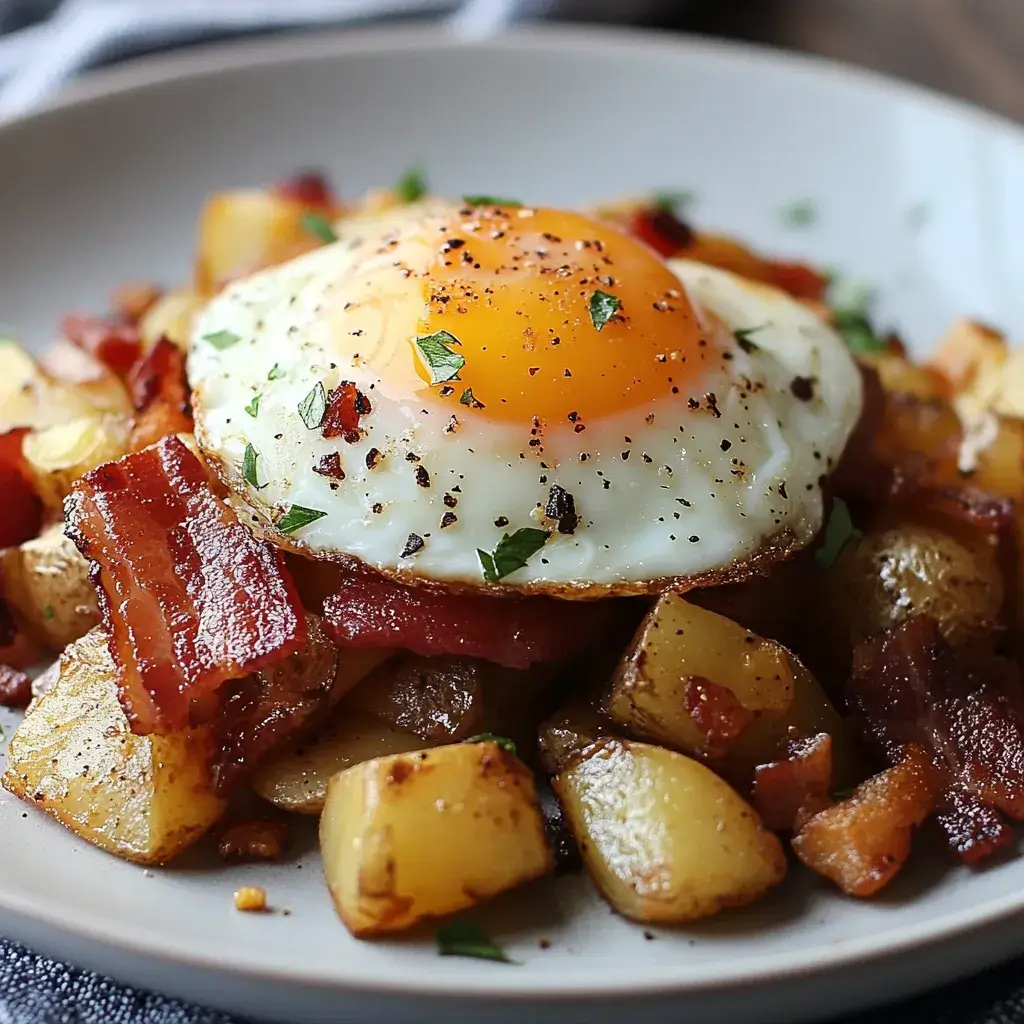
Before diving into the cooking process, it’s essential to prepare all your ingredients properly. Proper preparation ensures even cooking and enhances the overall taste of the dish.
Choosing the Right Potatoes
When selecting potatoes for your hash, opt for varieties that hold their shape well when cooked. Russet potatoes are a popular choice due to their starchy texture, which becomes crispy when fried. Yukon Gold potatoes are another excellent option, offering a buttery flavor and creamy interior. For best results, peel the potatoes, dice them into small cubes, and rinse them under cold water to remove excess starch. This step helps achieve perfectly crispy potatoes every time.
Cooking Perfectly Crispy Bacon
Achieving crispy bacon is crucial for the success of this recipe. Start by placing the strips in a cold skillet and turning the heat to medium-low. As the fat renders out, the bacon will slowly crisp up without burning. Alternatively, you can bake it in the oven at 400°F (200°C) for about 15-20 minutes. Once cooked, transfer the bacon to a paper towel-lined plate to absorb excess grease. Reserve the drippings—they’ll serve as the base for frying the potatoes.
Prepping Vegetables for Flavor
Vegetables like bell peppers and onions add color, sweetness, and aroma to the hash. Dice the vegetables into bite-sized pieces for uniform cooking. If you enjoy a bit of spice, consider adding minced garlic or diced jalapeños. These additions not only enhance the flavor but also make the dish more exciting. Remember to sauté the vegetables gently to preserve their natural sweetness and crunch.
Setting Up Your Workstation
Having the right tools makes cooking easier and more efficient. A cast iron skillet is ideal for this recipe because it retains heat well and promotes browning. Equip yourself with a sharp chef’s knife for chopping, a sturdy cutting board, and a spatula for stirring. Having everything within reach minimizes distractions and ensures smooth preparation.
Upgrade your breakfast with this Loaded Sandwich!
Step-by-Step Guide to Making Bacon, Egg, and Potato Hash
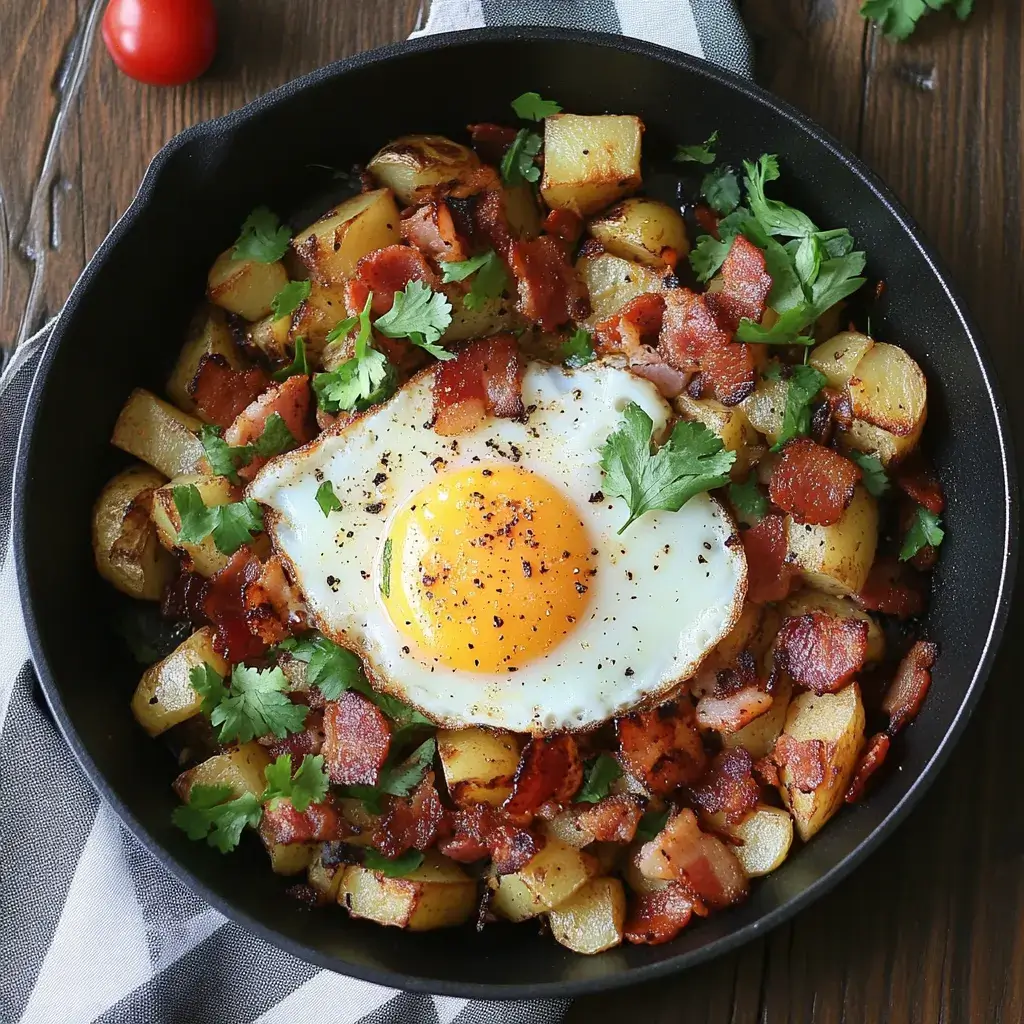
Now that your ingredients are prepped, let’s dive into the step-by-step process of creating this delicious hash.
Step 1: Cook the Bacon First
Begin by cooking the bacon in a large skillet over medium heat. Start with a cold pan to allow the fat to render gradually. As the bacon cooks, use a spatula to flip the strips occasionally to ensure even browning. Once they reach your desired level of crispiness, remove them from the skillet and set them aside. Leave the rendered fat in the pan—it will become the foundation for frying the potatoes.
Step 2: Sauté the Vegetables
Using the same skillet with the reserved bacon fat, add diced onions and bell peppers. Cook them over medium heat until they soften and become translucent. If using garlic, stir it in during the last minute of cooking to prevent burning. The goal is to caramelize the vegetables slightly, bringing out their natural sweetness and enhancing the overall flavor profile.
Step 3: Fry the Potatoes
Once the vegetables are cooked, push them to one side of the skillet and add the diced potatoes to the other side. Increase the heat to medium-high and cook the potatoes until they develop a golden-brown crust. Stir occasionally to ensure even cooking. Season generously with salt and pepper to enhance the flavors. The rendered bacon fat will infuse the potatoes with rich, savory notes.
Step 4: Add the Eggs
For the final touch, crack eggs directly into the skillet or scramble them separately before adding them to the hash. If you prefer sunny-side-up eggs, place them on top of the hash and cover the skillet to allow the whites to set while keeping the yolks runny. Alternatively, scramble the eggs and mix them gently into the hash for a creamy texture. Combine all the elements—potatoes, bacon, vegetables, and eggs—to create a harmonious dish.
Variations and Customizations
While the basic recipe is delightful, there are countless ways to personalize your Bacon, Egg, and Potato Hash. Here are some ideas to inspire your creativity.
Adding Cheese for Extra Flavor
Cheese takes this dish to the next level by adding richness and creaminess. Shredded cheddar is a classic choice, melting beautifully over the hash. Feta provides a tangy contrast, while Parmesan sprinkled on top adds a nutty finish. Experiment with different types of cheese to find your favorite pairing. Add the cheese toward the end of cooking so it melts evenly without burning.
Experimenting with Spices
Spices are a fantastic way to elevate the flavors of your hash. Paprika lends a smoky note, while cayenne pepper introduces a subtle heat. Chili powder combines earthy and spicy notes, making it an excellent addition for those who love bold flavors. Don’t forget herbs like thyme or rosemary, which complement the dish beautifully. Start with small amounts and adjust according to your taste preferences.
Vegan and Gluten-Free Options
For those following plant-based diets, there are plenty of ways to enjoy this hash. Replace traditional bacon with plant-based alternatives made from soy or mushrooms. These options mimic the texture and flavor of bacon while being entirely vegan. To keep the dish gluten-free, ensure that all seasonings and spices used are certified gluten-free. With these simple swaps, everyone can enjoy this comforting meal.
Serving Suggestions
This hash pairs wonderfully with various sides, depending on your mood. Serve it alongside toasted bread for dipping in the runny egg yolk. Avocado slices add freshness and healthy fats, while a side salad balances the richness of the dish. For a heartier meal, consider serving it with baked beans or roasted tomatoes.
Adding Cheese for Extra Flavor
If you’re looking to take your Bacon, Egg, and Potato Hash to the next level, adding cheese is a fantastic way to enhance its richness and creaminess. Shredded cheddar, feta, or Parmesan are all excellent options that complement the dish beautifully. For inspiration on how to incorporate cheese into your hash, check out this delightful recipe from Cafe Delites —it’s packed with cheesy goodness and sure to satisfy your cravings!
Nutritional Information and Health Benefits
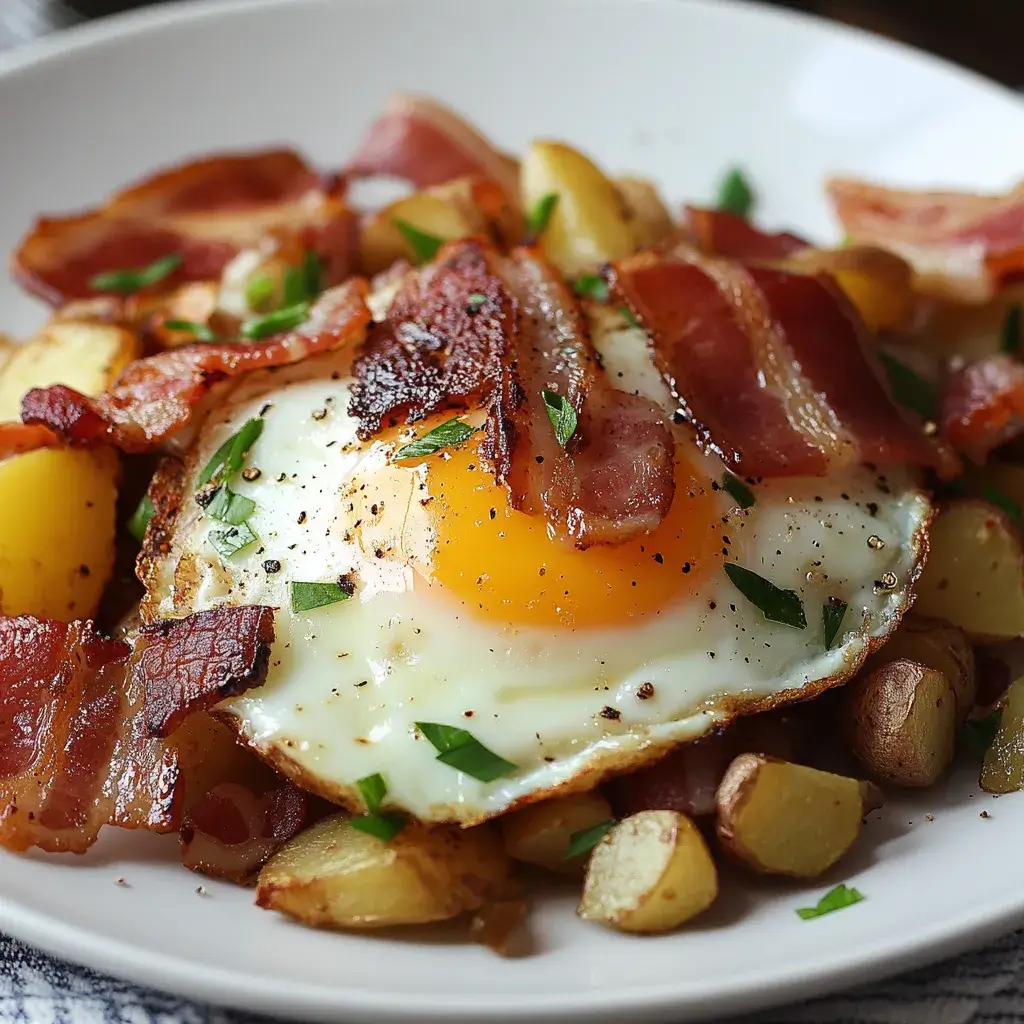
Understanding the nutritional value of your food empowers you to make informed choices. Let’s explore what makes this hash not only delicious but also nutritious.
Macronutrient Breakdown
Understanding the macronutrient composition of your meals is essential for maintaining a balanced diet. Let’s break down the key components of Bacon, Egg, and Potato Hash to help you better understand its nutritional profile.
Calories
A single serving of this hash typically contains around 400-500 calories, depending on portion sizes and additional ingredients. This calorie count makes it an excellent choice for breakfast, as it provides sufficient energy to kickstart your day. The combination of carbohydrates, proteins, and fats ensures that the calories come from a variety of sources, promoting satiety and sustained energy levels.
Protein
Protein is crucial for muscle repair, enzyme production, and overall body function. In this dish, eggs are the primary source of protein, providing approximately 6 grams per egg. Combined with the protein content of bacon (around 3-4 grams per serving), each portion delivers roughly 20 grams of high-quality protein. This amount is sufficient to support muscle maintenance and keep you full longer.
Carbohydrates
Carbohydrates are the body’s main source of energy, and potatoes contribute significantly to the carbohydrate content of this dish. A medium-sized potato contains about 30 grams of carbohydrates, including fiber. Fiber plays a vital role in digestion, helping regulate blood sugar levels and promoting gut health. By incorporating potatoes into your hash, you ensure a steady release of energy throughout the morning.
Fats
Fats are essential for brain function, hormone production, and nutrient absorption. In this recipe, fats come primarily from bacon drippings and eggs. A serving of hash contains approximately 25 grams of fat, which includes both saturated and unsaturated fats. While saturated fats should be consumed in moderation, the healthy fats found in eggs support heart health and provide essential fatty acids like omega-3s.
Balancing Macronutrients
The beauty of this dish lies in its balanced macronutrient profile. The combination of carbohydrates, proteins, and fats creates a meal that not only tastes great but also supports overall health. For those looking to adjust their intake, modifying portion sizes or substituting certain ingredients can help tailor the dish to individual dietary needs.
Health Benefits of Key Ingredients
Each ingredient in Bacon, Egg, and Potato Hash brings unique health benefits to the table. Understanding these advantages can help you appreciate the nutritional value of this classic dish.
Potatoes
Potatoes are often overlooked as a nutritious food, but they offer a wealth of vitamins and minerals:
- Vitamin C: Essential for immune system function, skin health, and collagen production.
- Vitamin B6: Supports brain development and function, as well as red blood cell formation.
- Potassium: Helps regulate fluid balance, nerve signals, and muscle contractions. Potatoes are one of the richest dietary sources of potassium.
- Fiber: Promotes digestive health and helps maintain stable blood sugar levels.
In addition to these nutrients, potatoes are low in sodium and free of cholesterol, making them a heart-healthy option when prepared using healthy cooking methods.
Eggs
Eggs are often referred to as nature’s multivitamin due to their impressive nutritional profile:
- High-Quality Protein: Contains all nine essential amino acids, making it a complete protein source.
- Vitamins D and B12: Vitamin D supports bone health and immune function, while B12 is crucial for nerve health and red blood cell production.
- Choline: An essential nutrient that plays a key role in brain development and memory.
- Lutein and Zeaxanthin: These antioxidants protect eye health by reducing the risk of age-related macular degeneration.
Including eggs in your diet can improve overall health and cognitive function, making them an indispensable part of this hash.
Bacon
While often considered indulgent, bacon offers several nutritional benefits in moderation:
- Zinc: Important for immune system function, wound healing, and DNA synthesis.
- Iron: Vital for oxygen transport in the blood and preventing anemia.
- Healthy Fats: Provide energy and aid in the absorption of fat-soluble vitamins like A, D, E, and K.
When consumed in controlled portions, bacon adds flavor and texture to meals while contributing valuable nutrients.
Vegetables
Bell peppers and onions, commonly used in hash recipes, bring additional health benefits:
- Bell Peppers: Rich in vitamin C, antioxidants, and fiber, bell peppers enhance immune function and promote heart health.
- Onions: Contain flavonoids and sulfur compounds that support cardiovascular health and reduce inflammation.
Together, these ingredients create a nutrient-dense dish that supports overall wellness.
Tips for a Lighter Version
If you’re looking to enjoy the flavors of Bacon, Egg, and Potato Hash while keeping it lighter, here are some practical tips to consider:
Reduce Portion Sizes
One of the simplest ways to lighten up this dish is by controlling portion sizes. Instead of piling your plate high, aim for a moderate serving that still satisfies your hunger. A smaller portion reduces calorie intake without sacrificing taste.
Use Lean Alternatives
For a healthier twist, consider using plant-based bacon substitutes made from soy or mushrooms. These alternatives mimic the texture and flavor of traditional bacon while being lower in fat and calories. Additionally, you can use turkey bacon substitutes if you prefer a meat-based option.
Increase Vegetable Content
Adding more vegetables to your hash not only boosts its nutritional value but also reduces the overall calorie density. Incorporate diced zucchini, spinach, or cherry tomatoes for extra color, flavor, and fiber. These additions make the dish more filling while keeping it light.
Opt for Whole Grains
If serving the hash with toast or bread, choose whole-grain options instead of refined grains. Whole grains contain more fiber, vitamins, and minerals, supporting better digestion and sustained energy levels.
Limit Added Oils
Since bacon already contributes fat to the dish, there’s no need to add extra oil during cooking. Use the rendered bacon fat to fry the potatoes and sauté the vegetables, minimizing unnecessary calories.
Choose Lower-Calorie Toppings
Instead of heavy sauces or toppings, garnish your hash with fresh herbs like parsley or cilantro. You can also sprinkle a small amount of grated cheese for added flavor without overloading on calories.
By implementing these tips, you can enjoy a lighter version of this beloved dish while still savoring its rich flavors and comforting textures.
Conclusion
Bacon, Egg, and Potato Hash is more than just a breakfast dish—it’s a celebration of flavor, texture, and simplicity. This hearty meal combines the comforting goodness of crispy bacon, fluffy eggs, and golden potatoes into one satisfying dish that can be enjoyed anytime, whether it’s a lazy weekend morning or a busy weekday breakfast.
Throughout this guide, we’ve explored the rich history and versatility of hash, delved into its key ingredients, provided a step-by-step recipe, and even offered tips for customizing it to suit different dietary preferences. From understanding its macronutrient breakdown to appreciating the health benefits of each ingredient, this dish proves that delicious food can also be nutritious and adaptable.
For those looking to lighten up their meals without sacrificing taste, there are countless ways to tweak the recipe—whether by reducing portion sizes, incorporating more vegetables, or opting for leaner alternatives. At the same time, traditionalists can revel in the classic combination of flavors that has made this dish a timeless favorite.
In conclusion, Bacon, Egg, and Potato Hash is not only a delicious way to start your day but also a versatile canvas for culinary creativity. Whether you’re cooking for yourself or sharing with loved ones, this dish promises to deliver warmth, satisfaction, and joy. So next time you’re in the kitchen, give this recipe a try—you won’t regret it!
Happy cooking, and enjoy every bite of this comforting classic.
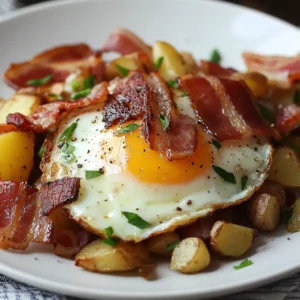
Bacon, Egg, and Potato Hash
Equipment
- Large skillet or frying pan
- Spatula
- Knife and cutting board (for chopping ingredients)
- Measuring cups and spoons
- Mixing bowl (optional, for cracking eggs)
Ingredients
- For the Hash:
- 6 slices of bacon chopped into small pieces
- 2 medium potatoes diced into small cubes, about 1/2 inch
- 1 medium onion diced
- 1 red bell pepper diced, optional
- 2 garlic cloves minced
- 4 large eggs
- Salt and pepper to taste
- Optional: Fresh parsley chopped, for garnish
- Optional: Hot sauce for serving
Instructions
- Cook the Bacon :
- In a large skillet over medium heat, cook the chopped bacon until crispy. Remove the bacon with a slotted spoon and set aside, leaving the bacon grease in the skillet.
- Cook the Potatoes :
- Add the diced potatoes to the skillet with the bacon grease. Cook over medium heat, stirring occasionally, for 10–12 minutes, or until the potatoes are golden brown and tender.
- Sauté the Vegetables :
- Add the diced onion and red bell pepper (if using) to the skillet. Cook for 5–7 minutes, stirring occasionally, until softened.
- Stir in the minced garlic and cook for 1 minute until fragrant.
- Add the Bacon Back :
- Return the cooked bacon to the skillet and stir to combine with the potato mixture. Season with salt and pepper to taste.
- Cook the Eggs :
- Use a spoon to create four small wells in the hash. Crack an egg into each well. Cover the skillet and cook for 5–7 minutes, or until the egg whites are set but the yolks are still runny (or cook longer if you prefer firmer yolks).
- Serve :
- Garnish with freshly chopped parsley if desired. Serve hot with hot sauce on the side, if preferred.
Notes
Use sweet potatoes instead of regular potatoes for a slightly sweeter flavor and added nutrition.
Store leftovers in an airtight container in the refrigerator for up to 2 days. Reheat gently on the stovetop or microwave.
Freeze portions of the hash (without eggs) for up to 3 months. Thaw overnight in the refrigerator before reheating and adding fresh eggs.

